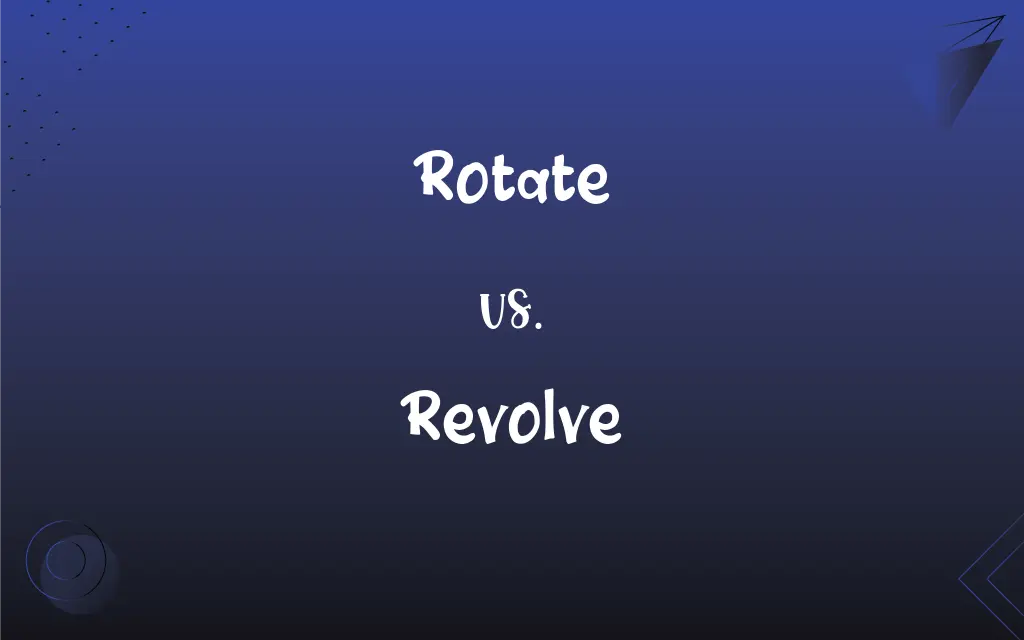Rotate vs. Revolve: What's the Difference?
Edited by Janet White || By Harlon Moss || Published on December 1, 2023
Rotate refers to an object turning around its own axis, while revolve means an object moving in a circular path around another object.

Key Differences
Rotate describes the action of an object spinning around its internal axis. Revolve is the movement of an object in an orbit or path around another object.
The Earth rotates on its axis, resulting in day and night. In contrast, the Earth revolves around the Sun, creating the year.
In machinery, parts rotate around fixed points, like gears in a clock. Celestial bodies, such as planets, revolve around stars in their respective solar systems.
Rotation can occur in any object capable of spinning, even at the molecular level. Revolution is specific to objects in space or those orbiting a central point.
The concept of rotation is used in various fields, from mechanics to ballet. Revolution, while also applicable in different contexts, is most commonly associated with astronomy.
ADVERTISEMENT
Comparison Chart
Definition
Turning around an internal axis
Moving in a path around another object
Example in Nature
Earth's spinning causing day and night
Earth's orbit around the Sun creating years
Application in Machinery
Gears rotating in a clock
Ferris wheel cabins revolving around the wheel
Level of Occurrence
Can occur at molecular to large scale
Typically larger scale, like celestial bodies
Common Fields of Reference
Mechanics, dance, sports
Astronomy, orbital mechanics
ADVERTISEMENT
Rotate and Revolve Definitions
Rotate
Rotate means to turn around a central axis or point.
The dancer performed a perfect pirouette, rotating gracefully on one foot.
Revolve
Revolve can refer to movement in a circular path around a center.
The children watched the model planets revolve around the model sun in the science exhibit.
Rotate
Rotate can refer to the movement of an object on its own axis.
The Earth rotates on its axis once every 24 hours.
Revolve
In a broader sense, revolve can mean focusing or centering around something.
The discussion revolved around the topic of renewable energy.
Rotate
Rotate is also used in scheduling or systems to indicate a regular change.
The hospital staff rotate shifts to ensure 24-hour coverage.
Revolve
Revolve is used to describe the continuous cycle of events or processes.
The agricultural year revolves around the seasons, dictating when to plant and harvest.
Rotate
In a technical context, rotate implies a circular movement around a fixed point.
The mechanic checked how smoothly the engine parts rotate.
Revolve
In astronomy, revolve is used to describe celestial bodies' orbits.
It takes about 365 days for the Earth to revolve around the Sun.
Rotate
Rotate can mean to change positions in a sequence.
The coach instructed the players to rotate positions to gain different experiences.
Revolve
Revolve means to orbit around an external point or object.
The Moon revolves around the Earth, creating its phases.
Rotate
To turn around on an axis or center.
Revolve
To orbit a central point
The planets revolve around the sun.
Rotate
To proceed in sequence; take turns or alternate
Interns will rotate through the various departments.
Revolve
To turn on an axis; rotate.
FAQs
Can planets both rotate and revolve?
Yes, planets rotate on their axes and revolve around stars.
What does rotate mean?
It means to turn or spin around an internal axis.
Do all objects that rotate also revolve?
Not necessarily; rotation and revolution are distinct movements.
Is rotation quicker than revolution?
It varies; rotation and revolution times differ among objects.
Does the Moon rotate or revolve around the Earth?
The Moon revolves around the Earth and also rotates on its axis.
Is revolution only an astronomical term?
While often used in astronomy, it can apply to other circular movements.
What does revolve mean?
Revolve refers to orbiting around another object or point.
Are rotations always visible?
Rotations can be visible or imperceptible, depending on scale and speed.
Can rotation occur in both directions?
Yes, objects can rotate clockwise or counterclockwise.
Are rotation speeds consistent?
Rotation speeds can vary widely among different objects.
How do rotations affect the Earth's climate?
The Earth's rotation causes the cycle of day and night.
Does revolution direction matter?
In space, the direction can determine orbital characteristics.
Do machines use both rotational and revolutionary movements?
Many machines use a combination of both for various functions.
Is rotational movement important in sports?
Yes, many sports involve rotational movement for power and precision.
How is revolution used in technology?
It's used in devices like turbines and wheels for motion.
What is an example of rotation in daily life?
A wheel rotating on a car as it moves is a common example.
Do all planets revolve at the same speed?
No, each planet has a unique revolution speed around its star.
What's an example of revolution outside astronomy?
A Ferris wheel's cabins revolve around the central point of the wheel.
How do revolutions influence seasons?
Earth's revolution around the Sun, along with its axial tilt, creates seasons.
Can humans perceive Earth's rotation and revolution?
Directly perceiving these movements is challenging due to their scale and our frame of reference.
About Author
Written by
Harlon MossHarlon is a seasoned quality moderator and accomplished content writer for Difference Wiki. An alumnus of the prestigious University of California, he earned his degree in Computer Science. Leveraging his academic background, Harlon brings a meticulous and informed perspective to his work, ensuring content accuracy and excellence.
Edited by
Janet WhiteJanet White has been an esteemed writer and blogger for Difference Wiki. Holding a Master's degree in Science and Medical Journalism from the prestigious Boston University, she has consistently demonstrated her expertise and passion for her field. When she's not immersed in her work, Janet relishes her time exercising, delving into a good book, and cherishing moments with friends and family.




































































